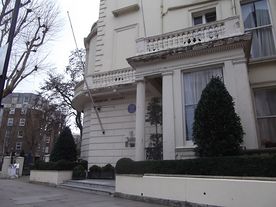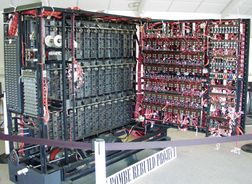SELF-GUIDED TECHNICAL HISTORY TOUR OF SITES ASSOCIATED WITH ALAN TURING
This tour was constructed by the Staff of the IEEE History Center.
Birthplace

http://blogs.nature.com/london/2011/03/16/the-scientific-tourist-in-london-17-alan-turings-birth-place
Alan Turing was born in Maida Vale, London, on 23 June 1912. The hospital in Warrington Crescent was converted to a hotel and bears a blue plaque in his honor.
Loading map...
{"minzoom":false,"maxzoom":false,"mappingservice":"leaflet","width":"auto","height":"350px","centre":{"text":"","title":"","link":"","lat":51.5243,"lon":-0.18443,"icon":""},"title":"","label":"","icon":"","lines":[],"polygons":[],"circles":[],"rectangles":[],"copycoords":false,"static":false,"zoom":12,"defzoom":14,"layers":["OpenStreetMap"],"image layers":[],"overlays":[],"resizable":false,"fullscreen":false,"scrollwheelzoom":true,"cluster":false,"clustermaxzoom":20,"clusterzoomonclick":true,"clustermaxradius":80,"clusterspiderfy":true,"geojson":"","clicktarget":"","imageLayers":[],"locations":[{"text":"","title":"","link":"","lat":51.5243,"lon":-0.18443,"icon":""}],"imageoverlays":null}
Early Education
Turing began studying at a boarding school in Sherborne in 1926, at 13 years old. His first day coincided with the 1926 General Strike in Britain, but he was so determined to attend that he rode his bicycle 60 miles, stopping overnight, on his own. Turing formed a significant friendship with fellow pupil Christopher Morcom, who died in 1930, which urged Turing to work even harder in their shared interests, which were mathematics and science.
Loading map...
{"minzoom":false,"maxzoom":false,"mappingservice":"leaflet","width":"auto","height":"350px","centre":{"text":"","title":"","link":"","lat":50.94,"lon":-2.4989,"icon":""},"title":"","label":"","icon":"","lines":[],"polygons":[],"circles":[],"rectangles":[],"copycoords":false,"static":false,"zoom":12,"defzoom":14,"layers":["OpenStreetMap"],"image layers":[],"overlays":[],"resizable":false,"fullscreen":false,"scrollwheelzoom":true,"cluster":false,"clustermaxzoom":20,"clusterzoomonclick":true,"clustermaxradius":80,"clusterspiderfy":true,"geojson":"","clicktarget":"","imageLayers":[],"locations":[{"text":"","title":"","link":"","lat":50.94,"lon":-2.4989,"icon":""}],"imageoverlays":null}
College Education
Turing went on to study at King's College, Cambridge, from 1931 to 1934. In 1935 he was elected a fellow of King's on his dissertation which proved the central limit theorem. In 1936 Turing famously published "On Computable Numbers, with an Application to the Entscheidungsproblem" in response to a problem proposed by David Hilbert in 1928. Turing proved that his "universal computing machine" (later called a Turing machine), could perform any mathematical computation if it was represented as an algorithm. The logic he set up in this paper is largely responsible for the concept of the modern computer.
Loading map...
{"minzoom":false,"maxzoom":false,"mappingservice":"leaflet","width":"auto","height":"350px","centre":{"text":"","title":"","link":"","lat":52.20366,"lon":0.11551,"icon":""},"title":"","label":"","icon":"","lines":[],"polygons":[],"circles":[],"rectangles":[],"copycoords":false,"static":false,"zoom":12,"defzoom":14,"layers":["OpenStreetMap"],"image layers":[],"overlays":[],"resizable":false,"fullscreen":false,"scrollwheelzoom":true,"cluster":false,"clustermaxzoom":20,"clusterzoomonclick":true,"clustermaxradius":80,"clusterspiderfy":true,"geojson":"","clicktarget":"","imageLayers":[],"locations":[{"text":"","title":"","link":"","lat":52.20366,"lon":0.11551,"icon":""}],"imageoverlays":null}
The United States
From 1936 to 1938 Turing resided in the U.S. while studying at Princeton University under Church, who developed a theory similar to Turing's back at King's College. Turing received a PhD from Princeton's Department of Mathematics in 1938 with a dissertation introducing the concept of ordinal logic and the notion of relative computing.
Loading map...
{"minzoom":false,"maxzoom":false,"mappingservice":"leaflet","width":"auto","height":"350px","centre":{"text":"","title":"","link":"","lat":40.3443,"lon":-74.6595,"icon":""},"title":"","label":"","icon":"","lines":[],"polygons":[],"circles":[],"rectangles":[],"copycoords":false,"static":false,"zoom":12,"defzoom":14,"layers":["OpenStreetMap"],"image layers":[],"overlays":[],"resizable":false,"fullscreen":false,"scrollwheelzoom":true,"cluster":false,"clustermaxzoom":20,"clusterzoomonclick":true,"clustermaxradius":80,"clusterspiderfy":true,"geojson":"","clicktarget":"","imageLayers":[],"locations":[{"text":"","title":"","link":"","lat":40.3443,"lon":-74.6595,"icon":""}],"imageoverlays":null}
Breaking the German Cipher

CC BY-SA 3.0, https://commons.wikimedia.org/w/index.php?curid=528200
Turing began work as a codebreaker for the Government Code and Cypher School in 1938, and reported to Bletchley Park the day after Britain declared war in 1939. His major accomplishment was the development of an electromechanical machine called the bombe, after the Polish bomba kryptologiczna which it replaced. It was largely automated and was used to crack Enigma-enciphered messages. Turing later turned his attention to the more complicated naval Enigma and made several advancements in its decryption.
Loading map...
{"minzoom":false,"maxzoom":false,"mappingservice":"leaflet","width":"auto","height":"350px","centre":{"text":"","title":"","link":"","lat":51.99736,"lon":-0.74017,"icon":""},"title":"","label":"","icon":"","lines":[],"polygons":[],"circles":[],"rectangles":[],"copycoords":false,"static":false,"zoom":12,"defzoom":14,"layers":["OpenStreetMap"],"image layers":[],"overlays":[],"resizable":false,"fullscreen":false,"scrollwheelzoom":true,"cluster":false,"clustermaxzoom":20,"clusterzoomonclick":true,"clustermaxradius":80,"clusterspiderfy":true,"geojson":"","clicktarget":"","imageLayers":[],"locations":[{"text":"","title":"","link":"","lat":51.99736,"lon":-0.74017,"icon":""}],"imageoverlays":null}
Back to the United States
In 1942 Turing returned to the United States and worked with U.S. Navy cryptoanalysts on the naval Enigma and bombe construction in Washington. He then assisted Bell Labs with the development of secure speech devices. In 1943 he returned to Bletchley Park and became a general consultant for cryptoanalysis.
Loading map...
{"minzoom":false,"maxzoom":false,"mappingservice":"leaflet","width":"auto","height":"350px","centre":{"text":"","title":"","link":"","lat":40.683978,"lon":-74.401267,"icon":""},"title":"","label":"","icon":"","lines":[],"polygons":[],"circles":[],"rectangles":[],"copycoords":false,"static":false,"zoom":12,"defzoom":14,"layers":["OpenStreetMap"],"image layers":[],"overlays":[],"resizable":false,"fullscreen":false,"scrollwheelzoom":true,"cluster":false,"clustermaxzoom":20,"clusterzoomonclick":true,"clustermaxradius":80,"clusterspiderfy":true,"geojson":"","clicktarget":"","imageLayers":[],"locations":[{"text":"","title":"","link":"","lat":40.683978,"lon":-74.401267,"icon":""}],"imageoverlays":null}
Post-War Computers
Turing moved to Hampton, London, after the war, where he remained until 1947, while working on the design of the ACE (Automatic Computing Engine) at the National Physical Laboratory (NPL). In 1946 he presented a paper which was the first detailed design of a stored-program computer.
Loading map...
{"minzoom":false,"maxzoom":false,"mappingservice":"leaflet","width":"auto","height":"350px","centre":{"text":"","title":"","link":"","lat":51.41516,"lon":-0.35946,"icon":""},"title":"","label":"","icon":"","lines":[],"polygons":[],"circles":[],"rectangles":[],"copycoords":false,"static":false,"zoom":12,"defzoom":14,"layers":["OpenStreetMap"],"image layers":[],"overlays":[],"resizable":false,"fullscreen":false,"scrollwheelzoom":true,"cluster":false,"clustermaxzoom":20,"clusterzoomonclick":true,"clustermaxradius":80,"clusterspiderfy":true,"geojson":"","clicktarget":"","imageLayers":[],"locations":[{"text":"","title":"","link":"","lat":51.41516,"lon":-0.35946,"icon":""}],"imageoverlays":null}
The Turing Test
In 1948 Turing became reader in the Mathematics Department at the Victoria University of Manchester, and soon became Deputy Director of the Computing Machine Laboratory, where he worked on the Manchester Mark 1. Here he published "Computing Machinery and Intelligence" in 1950, where he addressed artificial intelligence and developed the Turing Test to define a standard for when a machine can be called "intelligent." This concept of testing if a computer can be indistinguishable from a human in conversation is a foundation of artificial intelligence. The building he worked in is now called the Kilburn building after one of Turing's colleagues.
Loading map...
{"minzoom":false,"maxzoom":false,"mappingservice":"leaflet","width":"auto","height":"350px","centre":{"text":"","title":"","link":"","lat":53.467079,"lon":-2.234158,"icon":""},"title":"","label":"","icon":"","lines":[],"polygons":[],"circles":[],"rectangles":[],"copycoords":false,"static":false,"zoom":12,"defzoom":14,"layers":["OpenStreetMap"],"image layers":[],"overlays":[],"resizable":false,"fullscreen":false,"scrollwheelzoom":true,"cluster":false,"clustermaxzoom":20,"clusterzoomonclick":true,"clustermaxradius":80,"clusterspiderfy":true,"geojson":"","clicktarget":"","imageLayers":[],"locations":[{"text":"","title":"","link":"","lat":53.467079,"lon":-2.234158,"icon":""}],"imageoverlays":null}
Mathematical Biology
In 1951 Turing turned to mathematical biology, publishing "The Chemical Basis of Morphogenesis" in 1952, describing the development of form and pattern in living organisms. His work remains relevant today, despite being published before the structure and role of DNA was understood.
Conviction for Indecency
Turing spent his later years at the University of Manchester because in March 1952, he was convicted of "gross indecency," a law in Britain at the time that was used to convict homosexuals. He was sentenced to 12 months of hormone "therapy" which be bore without much backlash, while he continued his work. Due to his criminal record he could no longer work for the Government Communications Headquarters.
Death
While conducting research in June 1954, he was found dead, poisoned by cyanide, in his home in Wilmslow. The verdict was suicide despite the lack of clear evidence, and while it is often attributed to the hormones he received, the doses had ended over a year before, and there were no clear signs of mental imbalance. While suicide cannot be ruled out, it is possible that his death was accidental, from inhaling cyanide fumes from an experiment in his small laboratory adjoining his bedroom, and some even suggest that murder by the secret services is possible.
Loading map...
{"minzoom":false,"maxzoom":false,"mappingservice":"leaflet","width":"auto","height":"350px","centre":{"text":"","title":"","link":"","lat":53.328455,"lon":-2.207347,"icon":""},"title":"","label":"","icon":"","lines":[],"polygons":[],"circles":[],"rectangles":[],"copycoords":false,"static":false,"zoom":12,"defzoom":14,"layers":["OpenStreetMap"],"image layers":[],"overlays":[],"resizable":false,"fullscreen":false,"scrollwheelzoom":true,"cluster":false,"clustermaxzoom":20,"clusterzoomonclick":true,"clustermaxradius":80,"clusterspiderfy":true,"geojson":"","clicktarget":"","imageLayers":[],"locations":[{"text":"","title":"","link":"","lat":53.328455,"lon":-2.207347,"icon":""}],"imageoverlays":null}
Further Reading
https://www.britannica.com/biography/Alan-Turing
https://www.bbc.com/news/science-environment-18561092











































































































































